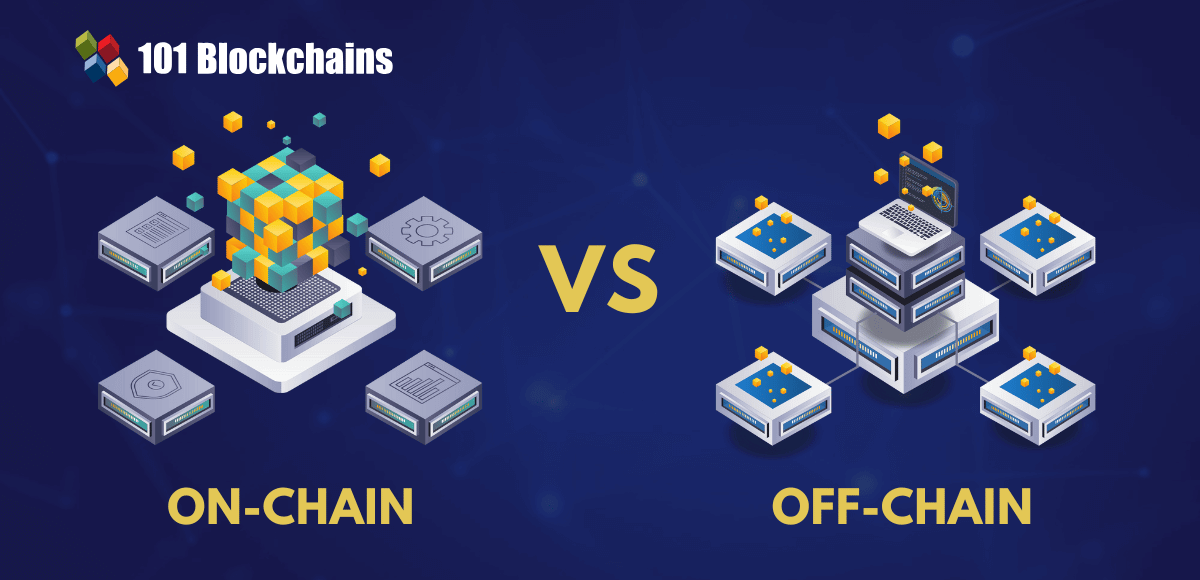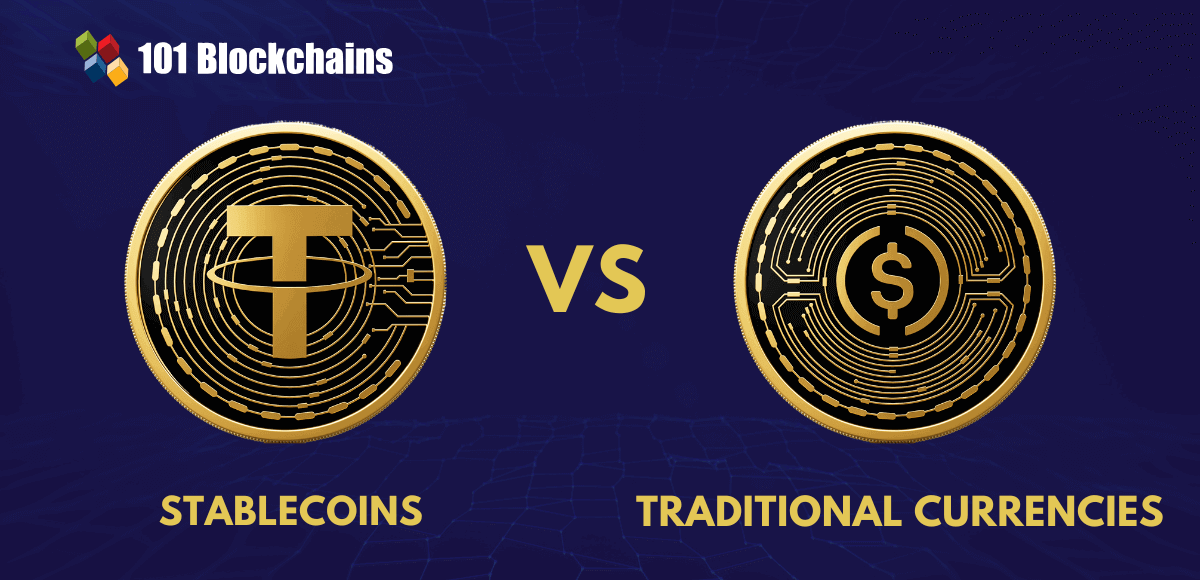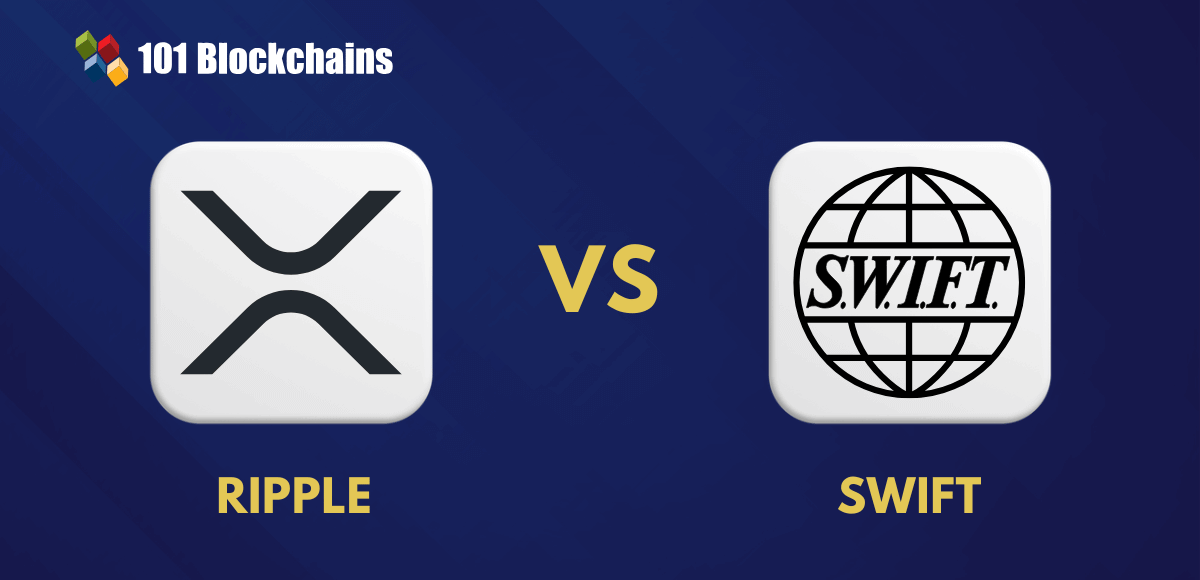Learn how blockchain truly works, master key definitions, and uncover what makes smart contracts so "smart." Dive into the fundamentals, gain valuable insights, and start your blockchain journey today!
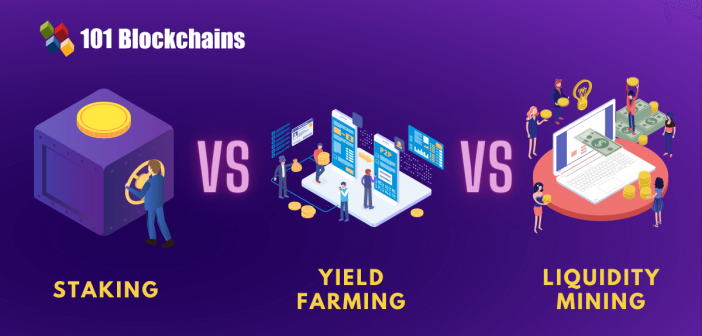
- Comparisons
Diego Geroni
- on November 18, 2021
Staking vs. Yield Farming vs. Liquidity Mining – Key Differences
Want to learn how Staking, Yield farming, and Liquidity mining are different from each other? Here’s the detailed difference among the three i.e. staking vs. yield farming vs. liquidity mining.
The DeFi space is growing, and there is no reason to deny it. Enterprises and individuals want to capitalize on the benefits of decentralized finance with the newly emerging solutions. Decentralized finance has not only opened up the possibilities for improved financial inclusion throughout the world but also strengthened the possibilities for using and managing digital assets.
The most notable factor which comes up in discussions about DeFi trading would refer to the staking vs. yield farming vs. liquidity mining differences. All three of them are popular solutions in the domain of DeFi for obtaining plausible returns on crypto assets. The three approaches differ in the way participants have to pledge their crypto assets in decentralized protocols or applications.
In addition, the underlying technologies also provide further indications of differences between staking and the other two approaches. The following discussion offers a detailed explanation of all the three strategies in DeFi which can help you earn productive returns on your crypto assets. You can understand yield farming alongside the other two strategies comprehensively for identifying possible differences between them.
Want to know more about DeFi? Enroll Now: Introduction to DeFi Course
Understanding Yield Farming
The first thing that you should take into account about yield farming is its definition. Yield generation is a popular approach for obtaining returns on crypto assets. Basically, it offers a flexible approach for earning passive income through depositing crypto assets in a liquidity pool.
The liquidity pools in the case of yield farming could refer to bank accounts in the conventional sense. Yield generation is the practice that involves investors locking in their crypto assets in liquidity pools based on smart contracts. Now, the assets locked in the liquidity pools are available for other users to borrow in the same protocol.
Yield farming is a crucial aspect of the DeFi ecosystem as it supports the foundation of DeFi protocols for enabling exchange and lending services. It is also essential for maintaining the liquidity of crypto assets on different decentralized exchanges or DEXs. Yield farmers could also earn rewards in the form of APY.
Want to explore in-depth about DeFi protocol and its use cases? Enroll in Decentralized Finance (Defi) Course- Intermediate Level Now!
-
Working of Yield Generation
In order to develop a better impression of yield generation in staking vs. yield farming vs. liquidity mining, it is important to understand how to yield generation works. First of all, it is important to note that Automated Market Makers or AMMs are responsible for yield farming.
AMMs are just smart contracts that leverage mathematical algorithms for enabling digital asset trading. Automated Market Makers play a highly critical role in yield farming for maintaining consistent liquidity as the transactions do not need any counterparties for the transaction. You could find two distinct components in AMMs such as liquidity pools and liquidity providers.
Liquidity pools are basically the smart contracts that drive the DeFi ecosystem. The pools include digital assets which can help users in purchasing, selling, borrowing, lending, and swapping tokens. On the other hand, liquidity providers are the users or investors who have locked their assets in the liquidity pool. Yield farming also offers a plausible foundation for easier trading of tokens with low trading volume in the open market.
-
Risks in Yield Farming
The understanding of staking vs. yield farming vs. liquidity mining can only get better with an awareness of risks with each. It is important to note that yield generation offers high risk and high reward ventures for investment. The notable risks with yield farming include impermanent loss, smart contract risk, composability risk, and liquidation risk.
Start learning Decentralized Finance (DeFi) with World’s first DeFi Skill Path with quality resources tailored by industry experts Now!
Understanding Staking
The second important entry in a debate on staking vs. yield farming vs. liquidity mining would obviously bring another notable and common consensus algorithm. Staking is basically an interesting way of pledging crypto assets as collateral in the case of blockchain networks leveraging the Proof-of-Stake algorithm. Just like miners use computational power for achieving consensus in Proof-of-Work blockchains, users with the highest stakes are selected for validating transactions on the PoS blockchains.
-
Working of the Proof of Stake Consensus
You might be wondering about the potential rewards for staking your crypto assets in a PoS blockchain-based DeFi protocol. First of all, you are investing in a highly scalable blockchain consensus algorithm with staking, which also ensures improved energy efficiency. Proof-of-Stake algorithms also create new avenues of opportunities for earning rewards.
With higher stakes in the protocol, investors could get better rewards from the network. It is important to note that rewards in the case of staking are allocated on-chain. Therefore, new tokens of the cryptocurrency are minted and distributed as staking rewards for the validation of each block. PoS blockchain does not imply the need for expensive computational equipment, thereby providing better usability.
-
Risks in Staking
The risks associated with Proof-of-Stake protocols are also another highlight in discussions on staking vs. yield farming vs. liquidity mining. Interestingly, the aspect of risk is considerably lower in the case of staking when compared to other approaches for passive investment. You should note that the safety of the staked tokens depends directly on the safety of the protocol.
At the same time, you would still notice some prominent risks in staking cryptocurrencies, such as slashing, volatility risks, validator risks, and server risks. In addition, you might have to encounter issues of loss or theft of funds, waiting periods for rewards, project failure, liquidity risks, minimum holdings, and extended lock-up periods.
Build your identity as a certified blockchain expert with 101 Blockchains’ Blockchain Certifications designed to provide enhanced career prospects.
Understanding Liquidity Mining
The final entry in the staking vs. yield farming vs. liquidity mining also deserves adequate attention when it comes to discussions on DeFi. As a matter of fact, liquidity mining serves as the core highlight in any DeFi project. Furthermore, it also focuses on offering improved liquidity in the DeFi protocols.
Participants have to offer their crypto assets to liquidity pools in DeFi protocols for the purpose of crypto trading. However, it is important to note that participants do not offer crypto assets into liquidity pools for crypto lending and borrowing in the case of liquidity mining. Investors place their crypto assets in trading pairs such as ETH/USDT, and the protocol offers a Liquidity Provider or LP token to them.
-
Working of Liquidity Mining
A deeper understanding of how liquidity mining works can help in anticipating its differences with the other strategies for crypto investment. The investors would receive rewards from the protocol for the tokens they place in the liquidity pool. The rewards in liquidity mining are in the form of native governance tokens, which are mined at every block.
In addition, investors also have the LP token from the first stage of locking their crypto assets into the liquidity pool. It is important to note that the reward in liquidity mining depends profoundly on the share in total pool liquidity. Furthermore, the newly minted tokens could also offer access to governance of a project alongside prospects for exchanging to obtain other cryptocurrencies or better rewards.
-
Risks in Liquidity Mining
The understanding of staking vs. yield farming vs. liquidity mining would be complete with an impression of their risks. Just like the other two approaches, liquidity mining also presents some notable risks such as impermanent loss, smart contract risks, and project risks. In addition, liquidity miners are also vulnerable to the rug pull effect in their projects.
Want to become a Cryptocurrency expert? Enroll Now in Cryptocurrency Fundamentals Course
Staking vs. Yield Farming vs. Liquidity Mining – Key Differences
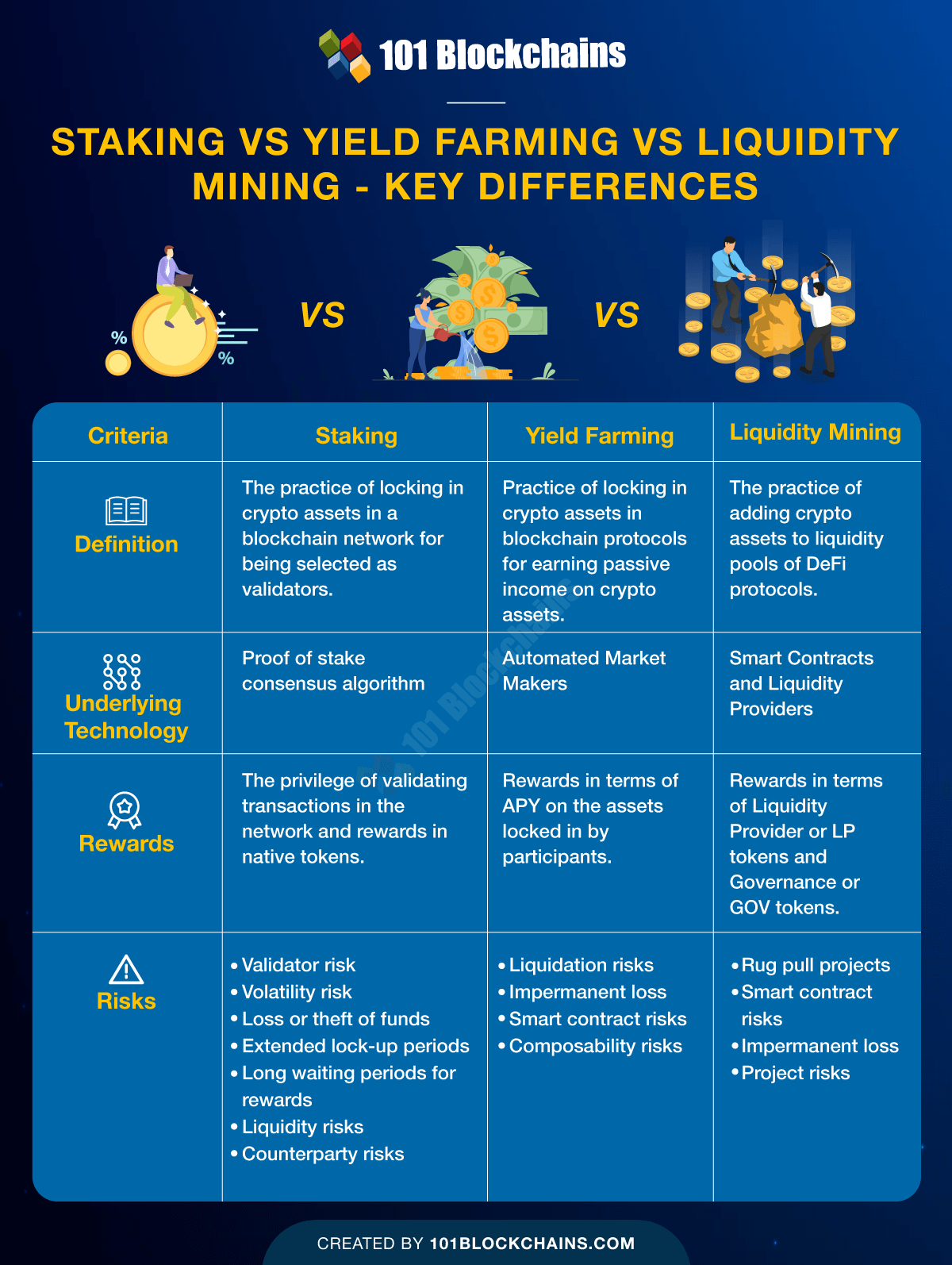
Please include attribution to 101blockchains.com with this graphic. <a href='https://101blockchains.com/blockchain-infographics/'> <img src='https://101blockchains.com/wp-content/uploads/2021/11/Staking-vs-Yield-Farming-vs-Liquidity-Mining-Key-Differences-1.png' alt='Staking vs Yield Farming vs Liquidity Mining='0' /> </a>
The differences between the three players in staking vs. yield farming vs. liquidity mining would refer directly to some key pointers. Here are some of them outlined in brief for your understanding.
Yield farming is a proven approach for investing your crypto assets in liquidity pools of protocols. Staking involves locking your crypto assets in the protocol in return for privileges to validate transactions on the protocol. Liquidity mining involves locking in crypto assets in protocols in return for governance privileges in the protocol.
In terms of objectives, yield farming aims to offer you the highest possible returns on the crypto assets of users. On the other hand, liquidity mining focuses on improving the liquidity of a DeFi protocol. Furthermore, staking emphasizes maintaining the security of a blockchain network.
Want to become a certified blockchain professional? Enroll Now: Certified Enterprise Blockchain Professional (CEBP)
Bottom Line
On a concluding note, it is quite clear that staking as well as yield generation and liquidity miners provide distinct approaches for investing crypto assets. The growing attention toward crypto assets is undoubtedly opening up many new opportunities for investors. However, investors need to understand the strategies they need to follow for the type of returns they are expecting.
Therefore, a clear impression of staking vs. yield farming vs. liquidity mining differences could help in making a plausible decision. Yield generation, liquidity mining, and Proof-of-Stake blockchains also have some setbacks you should look for. Start discovering more about yield farming and the other two crypto investment strategies now.
*Disclaimer: The article should not be taken as, and is not intended to provide any investment advice. Claims made in this article do not constitute investment advice and should not be taken as such. 101 Blockchains shall not be responsible for any loss sustained by any person who relies on this article. Do your own research!



